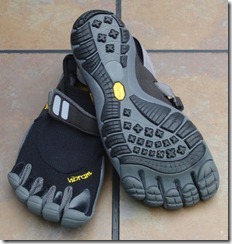 One of my biggest complaints about many of the scientific studies of barefoot and/or minimalist running is that they far too often fail to account for the possibility that form change is a prolonged process. They might take a habitually shod runner, ask them to remove their shoes, and have them run without any prolonged acclimation period to the new condition. My take is that it is highly unlikely that you will get a fluid representation of running form in the new condition if adaptation time is not allowed. This is particularly problematic in studies of running economy, as I would fully expect that individuals will be less economical if asked to perform a novel movement patter on the spot.
One of my biggest complaints about many of the scientific studies of barefoot and/or minimalist running is that they far too often fail to account for the possibility that form change is a prolonged process. They might take a habitually shod runner, ask them to remove their shoes, and have them run without any prolonged acclimation period to the new condition. My take is that it is highly unlikely that you will get a fluid representation of running form in the new condition if adaptation time is not allowed. This is particularly problematic in studies of running economy, as I would fully expect that individuals will be less economical if asked to perform a novel movement patter on the spot.
Applying this to the situation of a traditionally shod runner looking to work on their running form, putting on a pair of Vibram Fivefingers or similar barefoot-style shoe may not result in an instantaneous change. I’ve seen more than a few people in the race videos I have recorded who are heel striking in their Vibrams (e.g., see video below). This suggests to me that there is a learning component involved, and argues further that such a transition should be made both carefully and gradually.
An alternative hypothesis to that presented above is that heel striking is normal for some runners, and that they will do so no matter what they put on their feet. Indeed, in his well known study of barefoot vs. shod running, Daniel Lieberman of Harvard did observe some heel strikes among the habitually unshod Kenyans that he filmed (on a dirt road). Regardless, it is highly unlikely that any individual will overstride while barefoot and land on the heel with a highly dorsiflexed foot on a hard surface like a road (as is so often seen in runners wearing heavily cushioned shoes) – to do so would likely be a quick path to a calcaneal fracture.
One of the often overlooked aspects of Lieberman’s publication in Nature was the supplementary data that was included with it. Within this addendum was a section about a study he conducted looking specifically at the question of “if and/or how habitually shod RFS runners change their strike when they
transition from wearing running shoes to minimal footwear.”
Lieberman and his colleagues recruited 14 runners (avg. >20 km run/week) and provided each of them with a pair of Vibram Fivefingers Sprint shoes (the study was partially funded by Vibram). The subjects were provided instruction to increase mileage in the shoes very gradually over the course of six weeks, to a maximum of 16-20 km per week. They were provided no instruction on how to run in the Vibrams, so any change that occurred was due to experience running in the shoes (i.e., acclimation or learning). Subjects were each filmed prior to the six week trial period, and then again after the six weeks were over.
Lieberman et al. found that “over the course of the 6 week training period the plantar angle of the foot at strike transitioned to being 7.2° ± 3.2 s.d. more plantarflexed (p<0.05), and average ankle angle at impact became more plantarflexed by 5.6° ± 3.6 s.d. (p<0.05).” Furthermore, foot strike patterns changed as follows:
|
Week 0 |
Week 6 |
|
|
Strike Type |
% subjects (# subjects) |
% subjects (# subjects) |
|
Rearfoot |
72 (10) |
36 (5) |
|
Midfoot |
14 (2) |
0 |
|
Forefoot |
14 (2) |
57 (8) |
|
Toe Strike (no heel contact at all) |
0 |
7 (1) |
These results show that on average form changed significantly over the course of the six weeks of running in the Vibram Sprints. If we assume that the two forefoot strikers at the outset remained forefoot strikers after six weeks, then 7 of the 14 individuals changed their footstrike from either rearfoot or midfoot to forefoot/toe after acclimating to the shoes. Five individuals remained heel strikers. It’s worth noting that heel striking is more a spectrum than a category (e.g., variation occurs in joint angles, foot dorsiflexion), but from the data provided it is impossible to tell if the nature of the heel strike in these individuals changed. However, the fact that plantar angle of the foot relative to the ground was significantly flatter on average after the trial suggests that change in extent of heel strike may have occurred in these individuals as well (increased plantarflexion is commonly observed when shod runners are asked to run barefoot, even if they still heel strike – see De Wit et al., 2000 for one example). My own observations would also support this possibility – runners like the one in the video above who heel strike in Vibrams tend not to be highly dorsiflexed at the ankle upon ground contact (certainly not the 45 degree angle between the sole of the shoe and the ground I see in some people).
Before anyone screams that the study was funded by Vibram, thus the results are suspect, let’s take a look at another study (Squadrone and Gallozzi, 2009)that compared experienced barefoot runners while running barefoot, in Vibrams, and in traditional cushioned shoes. They found that when running in Vibram Fivefingers, the runners had a significantly more plantarflexed foot at ground contact when compared to running in standard cushioned shoes. Thus, the adaptations observed by Lieberman et al. are perfectly in line with what experienced barefoot/minimalist runners do.
What all of this suggests to me is that there is an adaptive response to running in an ultraminimal shoe like the Vibram Fivefingers, and that this response may take time to manifest itself. The fact that two people landed on their forefoot at the outset suggests that adaptation was immediate in these individuals (don’t know their pattern in cushioned shoes). Furthermore, the fact that some people altered foot strike after six weeks in Vibrams whereas others did not could reflect the fact that some individuals will heel strike no matter what (as a few habitually barefoot Kenyans observed by Lieberman did), or that adaptation occurs at different rates in different people (as I always like to emphasize, when it comes to biology, variation is the norm). It would be interesting to do the same study over a longer period of time, and also a parallel where some people were instructed on typical barefoot-style running form. This could help to further answer some of these questions.
Perhaps most importantly, these results, although published only as supplementary data and not as an actual journal article, make me suspect of any study that compares form in individuals based upon an “on the spot” change in footwear condition. Ingrained movement patterns can be difficult to change (ever try to write with your non-dominant hand? – really tough, but apparently it can be learned with time), and the ease with which form change might occur is probably highly variable from person to person. So, if you have the goal of modifying your running form by running barefoot or in ultraminimal shoes, be aware that though some changes may occur instantly, progressive change may continue to occur over a long period of time. Just how long it might take can be difficult to predict, and patience is therefore critical. Pushing too hard for a rapid change might just land you in a doctor’s office!
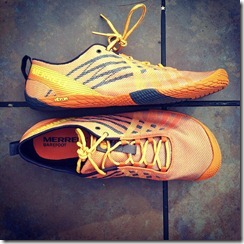
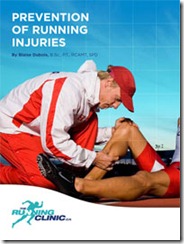

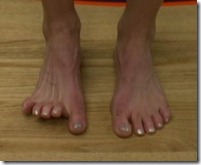
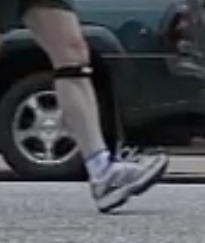














I just finished reviewing the Guiliani article and I too was somewhat skeptical that the link was made between the onset of a new injury occuring concurrently with the change in shoe wear. While possible, I find it difficult to make that association alone without taking into full account all of the other possible variables that may have contributed to the injury. Certainly a level of acclimation must occur before diving head first into minimalist running. I found another interesting article by Finestone et.al Epidemiology of metatarsal stress fractures versus tibial and femoral stress fractures during elite training. 2011 Foot and Ankle Int. They looked at several military recruits over the course of a year as they sequentially progressed through increasing levels of training. What they found was that there was an acclimation period that ultimately resulted in decreased incidence of stress fractures in the femur and tibia over the course of the year but no change in the incidence of metatarsal stress fractures. While shoe wear was not the controlled variable, it goes to show that even the most well trained and fit runners may be subject to these injuries no matter the footwear. From a personal perspective I strongly believe in an acclimation and learning period for minimalist running. My calves will attest to that!
I had one Invisible Shoes customer tell me that he’d been running 15-20 miles per week barefoot for over 3 years. And then, off-handedly, he mentioned an occasional problem he had. I can’t remember exactly what he said, but I remember replying, “Oh, you have a form problem.”
“No,” he reminded me, “I’ve been running barefoot for 3 years.”
“Yeah,” I said, “you’ve been doing it wrong for 3 years” (I was in a glib mood, and I sensed that he could take a minor ribbing). “In fact, I bet that when you put on these sandals and go running you’re going to hear a loud slapping noise… that you won’t hear from me when I run next to you.”
Sure enough, he put on his sandals, we went for a run and… SLAP, SLAP, SLAP.
“You’ve been overstriding for 3 years, and overstriding causes the problem you reported and results in slapping noises when you wear sandals.”
I gave him a couple of cues and within a few minutes he changed his stride. Did it stick? I don’t know.
But now that I’ve seen thousands of barefoot runners, I can tell you: Some people are more aware of their sensations than others. Some people adapt and change faster than others. Some people think they need to “work through the pain” and other try to find a way to get rid of pain. Some people are more adept at trying different movement patterns than others.
In other words, JUST taking off your shoes is not necessarily enough (whether you go barefoot, in VFFs or in Invisible Shoes).
I think form change is definitely gradual. Even when I started barefoot running, I realized that running faster than what my body was used to, I would revert back to a rearfoot strike…as evidence by my pealing skin on my heal and intense sensitivity in the heal area. Also, I’m not sure that KSO’s help speed up this process at all. In fact, I’ve seen it completely destroy this process. I have a pair of Vibram KSO’s myself, and can definitely see the advantages of wearing them to learn minimalistic running. However, the issue that I’ve seen with them is that they provide too much cushion. Yes…too much cushion. What I’m about to say is all my own opinion, so take it with a grain of salt. The hard layer of thick plastic that separates your feet from the feel of the ground is what makes the the learning curve so tough, and causes injury. I can’t remember where I heard this before (I think it was from some video with Liebermann), but the heal of your foot is one of the more sensitive parts of your body. Running barefoot exposes your body and your heal to the intense sensation of barefoot striking, and causes you to strike forefoot or midfoot. I honestly think that this learning curve is retarded by the fact that KSO’s have that protective layer of plastic. People who strike with their heals, continue to do so. In some people that I’ve observed, their body and strides have not changed at all. They are in fact not gradually growing, but staying exactly the same.
Pete you’re prolific! Another interesting post.
This post, and the one on metarsial stress fractures made me think about the phases of transition of adaptation of the gait, and the muscles, tendons and bones. The study discussed above shows that it a tranistion in gait can happen in 6 weeks, and I’d expect that the gait changes will also be in unison with muscle and tending strengthing. I’d also suggest that gait changes will lead the soft tissue changes, but full gait changes won’t be able to retainied for long distances untill the soft tissue is strong enough. This would be the initial phase of transition.The end of intial phase the gait has changed, and the muscles are now strong enough to support extended periods of running and at faster paces. Now into the second phase, running further and faster puts more stress on the bones, and with these new stresses they could either start to fail and we’ll see stress fractures, or if we are more gradual about the upping the stress the bones density will start to increase and they will become stronger and be able to handle the increasing loads. There is a fine line to tread here, and one we aren’t neccesserily used to detecting. We all know about over doing and having aching muscles in the days following a hard run, we can take it easy for a couple of days and then we’re back even stronger. Contrast this to bones stress and regrowth – unless you really overdo it’s difficult to know that the bones are struggling to keep up, and the regrowth is far slower than muscles. It’s also all to easy to put ache and pains as familiar soft tissue complaints and not spot bones stress as the source.I would even stick my neck out and proposing the idea that perhaps those who don’t adapt their gait quickly might be at lower risk of bone injuries. It could be that those heel strikers in Vibrams might not have the prettiest gait, but perhaps they could be using their body in a similar enough way to what it’s used that it’s not overloaded.I’ll finish with a question for those with more knowledge about medicial side – how long does it take for bones to become stronger? And what is the best stimulus for bone growth? Are there things we can do to make ourselves more aware of where the line between stress that causes bone growth and overdoing it and accumulating damage faster than it’s repared?
Robert – I think you are spot on here. Regarding your question about timing
of bone remodeling, I hopefully have something in the works. Muscles adapt
quickly, bones take longer, and this may very well play a role in why
fractures sometimes occur a few months after beginning the transition. Also
wonder how long it takes a stress fracture to develop to the point where it
is noticed…
Pete
I wonder if training/social media like dailymile might be able to developmed so that they might specifically support those that are new to running/transitioning to a new gait/footware.
I’m thinking of automating things like the 10% rule of thumb, giving runners a heads up that they might be increasing their risk of injury. One could also use online reporting of ache and pains such that an expert system could pick out possible injury patterns. Perhaps one could start with a system where it’s collecting data for analysis and as patterns emerge the expert system could get better at picking out likely problems.
Such a system could easily be used by health care professionals in both research and in diagnosis and final treatement. There are potential privacy issues one would have to deal with, so one wouldn’t want to put too much information in the system.
One could start with just adding a little to what is already gathered on sites like dailymile/sportpal/etc, so from mile+pace one would add the actual shoe used. Knowing which shoe (or lack of) would allow the system to know how long that particular shoe had been worn, how long a runners has been in that shoe type. The next stage would be adding in enabling the logging of aches and pains on different sites on the body. Being able to associate pictures or video with runs might be another diagnositic tool – for either crowd sourcing a diagnosis or providing this to professionals.
Such a system you’d want to just use regardless of whether you are injured or not, it’d need to be fun and easy to use. I’m not about to volunteer to write such a system, but maybe those who have might see an opportunity to add to their system…
So this is interesting post as always. I am not running in 5 Fingers but I am running in a somewhat minimal shoe. My form has changed nonetheless. I definitely land more plantar flexed and I think I hit mid-foot. If not mid then definitely a more plantar flexed heel strike. But this took weeks to achieve and was not pain free. Definitely had calf pain, ankle pain and hip flexor pain. I have no idea if any or all of these issues are related to being more plantar flexed. As for the knees, I have found this style to be excellent and very nice on the knees. I personally believe it is because you land slightly bent knee and relatively close to your hip line…great for my knees so far. Pete is so right…this is a process rather than a light switch.
I read somewhere that if you start completely barefoot, sore skin under your feet will limit your mileage, and thus, ironically, speed up transition. Seems like a good rule of thumb. I started in flats and it went fine, but maybe for a lighter runner than me the punishment for mistakes is less, and all the way barefoot can be a good way to correct this. As close to foolproof as it gets?
Anyway thanks for a good article.